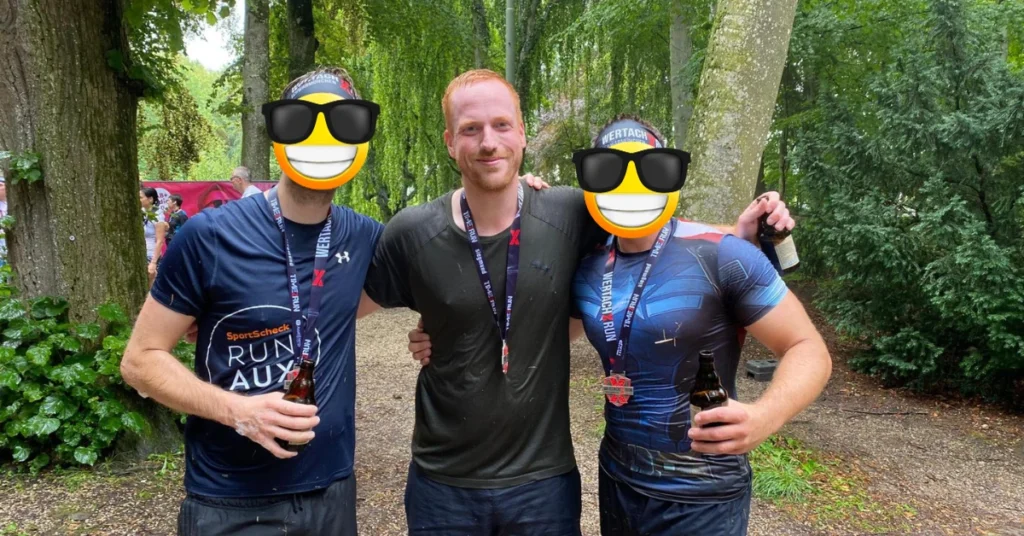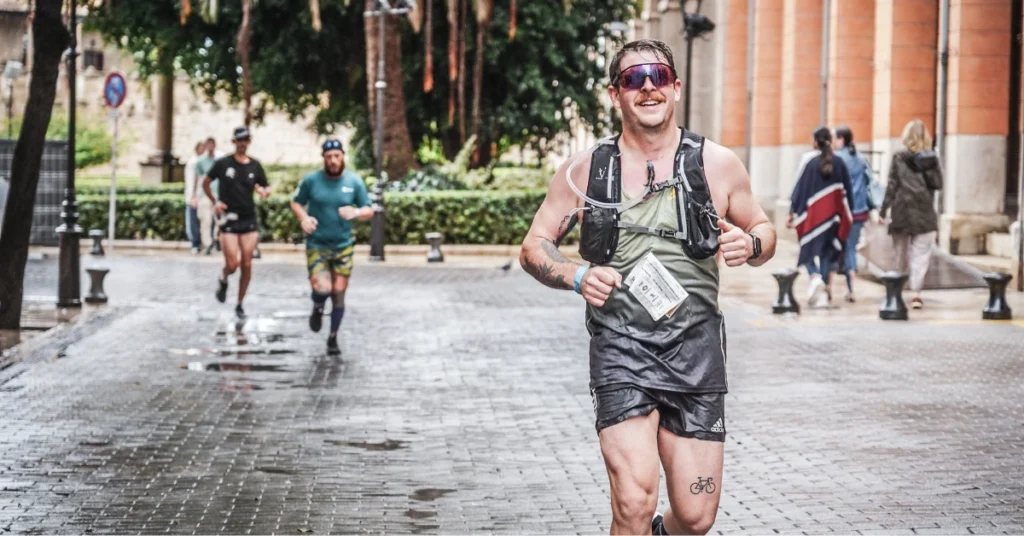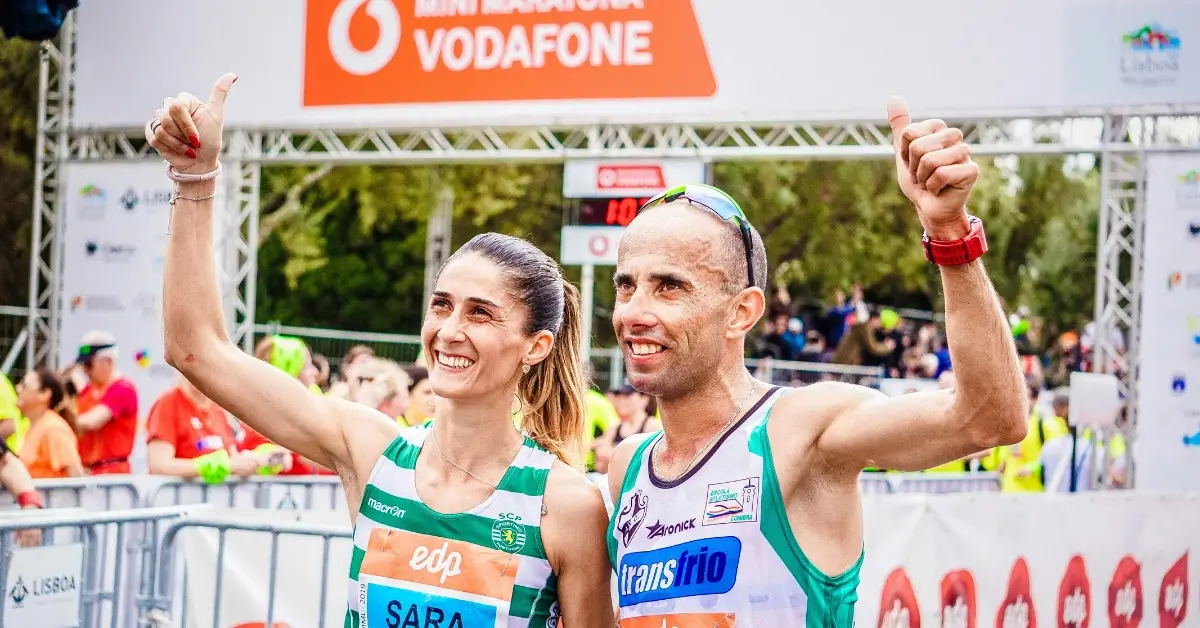A half marathon is an endurance running event that covers a distance of 13.1 miles. Whether you’re a seasoned athlete looking to push your limits or a beginner eager to tackle your first long-distance race, completing a half marathon is a challenging yet achievable goal. This article will guide you through the preparation and training required to successfully conquer this 13.1-mile feat, both physically and mentally.
Pro´s:
- ✅ Exceptional moisture-wicking keeps my feet dry.
- ✅ The snug fit prevents slipping and bunching.
- ✅ No blisters after even the harshest runs.
Con`s:
- ❌ The price point is higher compared to other options.
Understanding: How Much is a Half Marathon
When we consider participating in a race, the half marathon often emerges as an appealing choice. This race distance strikes a balance, offering a substantial challenge without the extended training commitment of a full marathon.
Distance: A half marathon is precisely 13.1 miles (21.0975 kilometers). It’s half the distance of a full marathon and serves as a fantastic goal for runners looking to push their endurance in a manageable way.
Popularity: The allure of the half marathon lies in its approachability. Whether you’re new to running or an experienced marathoner, this distance is a popular milestone.
Training: For our training, we don’t necessarily have to run 13.1 miles before race day. Most training plans gradually increase our mileage, focusing on building our stamina and speed over weeks.
Race Day: On the day of the half marathon, it’s common to see a mix of runners, from those tackling their first long-distance race to seasoned athletes looking to hit a new personal record.
| Essential Info | Details |
|---|---|
| Distance Covered | 13.1 miles / 21 km |
| Common Training Plan Duration | 10 to 16 weeks |
| Terrain | Varies by race |

“By preparing ourselves for this rewarding endeavor, we not only experience the physical benefits of running a significant distance, but we also enjoy a sense of achievement upon crossing that finish line.”
Essential Gear and Equipment

When we hit the pavement for a half marathon, the right gear can make all the difference between a good run and a great one. We’ll need a combination of proper footwear, apparel, and equipment to not only improve our performance but also to ensure we stay comfortable and safe throughout the race.
🏃 Choosing the Right Running Shoes
Finding the perfect running shoes is crucial for our half marathon success. Our shoes should offer a balance of support, cushioning, and fit to keep our feet comfortable over the 13.1 miles. It’s important that we get our gait analyzed and choose shoes that work well with our stride to prevent injuries.
🩳 Selecting Comfortable Clothing
The clothes we wear can affect how we feel during the race. We want clothing that’s weather-appropriate, made of moisture-wicking fabric to keep us dry, and fits well without causing chafing. Layering options are also a smart choice for unpredictable weather conditions.
🚰 Hydration and Fueling Essentials
Staying hydrated is key, so we should include a hydration system, like a belt with water bottles or a running vest. For fueling, carrying energy gels or chews can provide us the necessary boost. It’s essential to practice with these beforehand to avoid any race-day digestion issues.
🎧 Additional Accessories and Technology
Besides the basics, consider other accessories like sunglasses, a hat, or sunscreen for protection against the elements. Technology like a GPS watch can track our pace and distance – a helpful tool for staying on target. We must also remember essentials like our bib number and safety pins to secure it.
By ensuring we have all these key items, we’re setting ourselves up for a half marathon experience that’s not only enjoyable but also optimized for our best performance.
Half Marathon Training Basics

Embarking on a half marathon journey is both exciting and challenging. We’ll walk through creating a solid training plan, share beginner tips, build your endurance and strength, and dish out advice on speed work to prepare well.
📋 Creating a Training Plan
Creating our half marathon training plan is a blend of commitment and adaptability. Consistent training, over a period of 12 weeks, is typical for beginners, with gradual mileage increases each week. We’ll weave in rest days to strike a balance between challenge and recovery. For seasoned runners, training might span fewer weeks but include higher intensities and volumes.
🏃♀️ Beginner Training Tips
For our beginner runners, starting slowly is key. Don’t rush the process. Starting with a 5k distance and progressively increasing our long run every week is a sustainable approach. Listening to our bodies and adjusting accordingly helps avoid injury and burnout. Remember, running should be enjoyable, not a chore.
💪 Building Endurance and Strength
Endurance and strength are the cornerstones for successful half marathon training. Our long runs, which cap our weekly mileage, are essential for building endurance, and these should be done at an easy pace. Complementing running with strength training twice a week will fortify our muscles and improve our running form.
🏁 Incorporating Speed Work
Once we’re comfortable with our mileage, it’s time to sprinkle in speed work. Introducing tempo runs and intervals can elevate our fitness and running efficiency. Tempo runs improve our lactate threshold, while intervals enhance our speed and power. Both are vital for a strong finish on race day. Remember to start with a warm-up and end with a cool-down to keep our muscles limber.
Advanced Training Techniques

When we aim for personal bests or competitive times in a half marathon, refining advanced training techniques is crucial. We’ll focus on perfecting running form, understanding the tapering process, and mastering pacing strategies to maximize performance and endurance.
🏃 Perfecting Your Running Form
Good running form is essential for efficiency and preventing injuries. We ensure our head is up, shoulders relaxed, and torso stable. Running coaches often emphasize a cadence of around 180 steps per minute, as a higher cadence could lower the risk of injury by minimizing time spent on the ground.
🛌 Understanding Taper and Recovery
Tapering refers to reducing the volume and intensity of our workouts before a race, allowing our bodies to recover and store energy. In the last two weeks leading up to the race, we follow a taper schedule that systematically decreases our training load while maintaining some level of intensity. Post-race, recovery is just as important; we give our muscles time to repair and our energy reserves time to replenish.
- Weeks prior to race:
- 3 weeks: Reduce weekly mileage by 10-20%
- 2 weeks: Reduce weekly mileage by 20-30%
- 1 week: Reduce weekly mileage by further 20-30% and focus on rest
🕒 Mastering Pacing Strategies
To finish a half marathon in our goal time, we need to be mindful of our pace from the start. Using a pace chart can be a helpful way to ensure we’re on track. For instance, if we aim to finish a half marathon in under 1 hour and 30 minutes, our average pace should be around 6:52 per mile.
We also practice pacing on our long runs and use technology like GPS watches to help us maintain a steady pace and manage our power output throughout the race.
Nutrition and Hydration
Proper nutrition and hydration are pivotal for our performance and recovery in a half marathon. We need to focus on our fueling strategy as well as when and how much to drink to maintain our optimum energy levels throughout training and race day.
🍏 Fueling Strategy for Training and Race Day
When training for a half marathon, we need to ensure our bodies have the right fuel to endure the long distances. A mix of carbohydrates, proteins, and fats constitute our daily regimen, but our intake is highly dependent on the intensity and duration of training.
One way to maintain energy levels during runs is to use energy gels. These gels are designed to be digested quickly, providing a rapid source of energy. On race day, we should aim to replicate our practiced fueling strategy, eating familiar foods that we know won’t cause any digestive issues.
- Breakfast: A balanced meal 2-3 hours before the race, rich in carbohydrates
- During the Race: Consume a gel or chew every 30-45 minutes to keep energy up
- Post-Race: Eat a meal with protein to aid in muscle recovery.
🚰 Hydration Before, During, and After Runs
We must remain vigilant about our hydration levels. Before a run, aim to drink fluids throughout the day, verifying hydration by the color of our urine—it should be pale yellow. During the run, follow a hydration plan that replenishes fluids without overdoing it; our thirst is a good indicator to rely on.
Sports drinks can be helpful as they replace electrolytes lost through sweat. After finishing, we should focus on rehydrating, particularly if the weather was warm or the race especially taxing.
- Pre-Run: Drink about 16-20 ounces of water 2-3 hours before starting
- During the Run: Hydrate at regular intervals taking sips, not gulps
- Post-Run Hydration: Replace lost fluids gradually over the next few hours.
Cross-Training and Recovery

Incorporating cross-training activities and ensuring adequate rest and sleep are crucial for half marathon recovery. These components help us reduce injury risks and improve our overall fitness.
🏊 Integrating Cross-Training Activities
To boost our recovery and enhance our running performance, we can engage in low-impact cross-training activities. Swimming, for instance, is an excellent way to maintain cardiovascular fitness without putting stress on our joints. It allows us to recover actively while giving our running muscles a much-needed break. Other beneficial cross-training practices might include cycling or yoga, each contributing to our muscle strength and flexibility.
- Swimming: Gentle on the body and helps maintain endurance
- Cycling: Builds leg strength while being easy on the knees
- Yoga: Increases flexibility and aids in muscle recovery
😴 The Importance of Rest Days and Sleep
Rest days are not just about taking a break from physical activity; they are essential for allowing our muscles to repair and grow stronger. Schedule regular rest days to avoid overtraining and reduce injury risk.
When it comes to sleep, it’s not just about the duration but also the quality. Ensuring we get enough deep sleep will significantly enhance our recovery. Aim for 7-9 hours of high-quality sleep each night to support the body’s healing process.
- Rest Days: Critical to prevent overtraining and injuries
- Sleep: Aims for 7-9 hours of quality sleep to optimize recovery
Race Day Preparation
As we approach race day, it’s crucial for us to solidify our plans and anticipate what the day will bring. Being prepared for the different aspects of race day can make all the difference in our half marathon experience.
🏁 Finalizing Your Plan and Strategy
Before we lace up our running shoes, let’s review our strategy for the race. Here are some specific steps we should take:
- Review the Course Map: Familiarize ourselves with the race route, noting any elevation changes and water stations.
- Plan for Weather: Check the forecast and prepare appropriate gear. Whether it’s sunny or raining, we should be ready for the weather conditions.
🏃 What to Expect on Race Day
Race day can be bustling and full of energy. Here’s what we should be ready for:
- Starting Line Logistics: We’ll line up according to our expected pace. It’s important to start in the correct area to avoid a crowded field.
- Pacing Ourselves: Remember, half marathons are endurance races. We should keep a consistent pace that aligns with our training.
- Hydration and Fueling: Take advantage of water stations throughout the race to stay hydrated. If we’ve practiced with energy gels or chews, race day is the time to use them.
It’s vital to keep these specifics in mind as we set off to conquer the 13.1 miles that lay ahead. With careful preparation, we’re setting ourselves up for a successful and enjoyable race day.
Mental Preparation and Support

In the journey of completing a half marathon, our mental preparation is just as crucial as our physical training. It’s about nurturing a mindset that can handle the distance, and surrounding ourselves with a supportive network that helps motivate us to achieve our running goals.
🧠 Building Mental Resilience
Building mental resilience is an essential part of our half marathon training. As runners, we need to cultivate positivity and harness techniques like positive self-talk and visualization. We practice reminding ourselves of our dedication and commitment, which bolster our resilience against the mental fatigue that might set in during the long miles.
🤝 The Role of a Support System
Having a robust support system is invaluable to us as we pursue our running goals. Our support system might include friends who encourage us, running groups we join for that sense of membership, or coaches guiding us along our journey. This network provides the support we need to stay motivated every step of the way. By fostering meaningful connections, we fortify our mental toughness with the energy and enthusiasm of others.
Beyond the Half Marathon
After conquering a half marathon, the journey doesn’t stop there. We have a plethora of options to challenge ourselves further, from increasing distances to tackling a full marathon.
🏃 From 5K to Ultra: Progressing in Distance
Let’s map out our trajectory. Many of us start with a 5K, a fun and accessible race that spans approximately 3.1 miles. Once we’ve got that under our belt, 10K races (6.2 miles) offer a middle ground before we graduate to a 15K (9.3 miles). Each step demands more from us – greater endurance, pace, and training.
🏅 Transitioning to Full Marathons
Shifting from 13.1 miles to a full marathon (26.2 miles), requires a strategic approach. It’s not just about doubling our distance; we need to consider enhanced training schedules, nutrition, and recovery times.
Our Opinion on How Much is a Half Marathon


A half marathon is a road race that amounts to exactly 13.1 miles (21.1 kilometers). It’s half the distance of a full marathon and serves as an excellent challenge for runners of various skill levels.
In terms of time commitment for a half marathon, it largely depends on our personal goals and running background. For those of us starting from scratch, we might take 12 to 14 weeks of training before we’re race-ready. However, if some of us have a baseline level of fitness, we may require a shorter preparation time.
Regarding the financial aspect, a half marathon entry fee can vary. It typically ranges from $50 to $200, often influenced by the size and prestige of the event. It’s wise for us to register early, as fees tend to increase closer to the race date.
These are the key points we need to keep in mind about half marathons:
- Distance: 13.1 miles / 21.1 kilometers
- Training Time: 12 – 14 weeks for beginners
- Cost: $50 – $200, depending on the event
We find half marathons to be a rewarding balance, offering substantial physical and mental challenges without the extensive time commitment of full marathon training. For us, it’s a perfect way to push our boundaries while still fitting into our busy schedules.
FAQ
How much is a half marathon in km?
A half marathon is equivalent to 21.0975 kilometers.
How long does it take to run 21 km for beginners?
For beginners, completing a 21 km run, such as a half marathon, can take anywhere from 2 to 3 hours, depending on individual fitness levels and training.
Can you do a half marathon without training?
While it is technically possible to complete a half marathon without training, it is not recommended. Adequate training is crucial for preventing injuries and ensuring a successful and enjoyable race experience.
What is your option for our How Much is a Half Marathon? I would love to hear it in the comments. I’m sure you also like reading about our 10 week half marathon training or about the best handheld water bottle for running.



